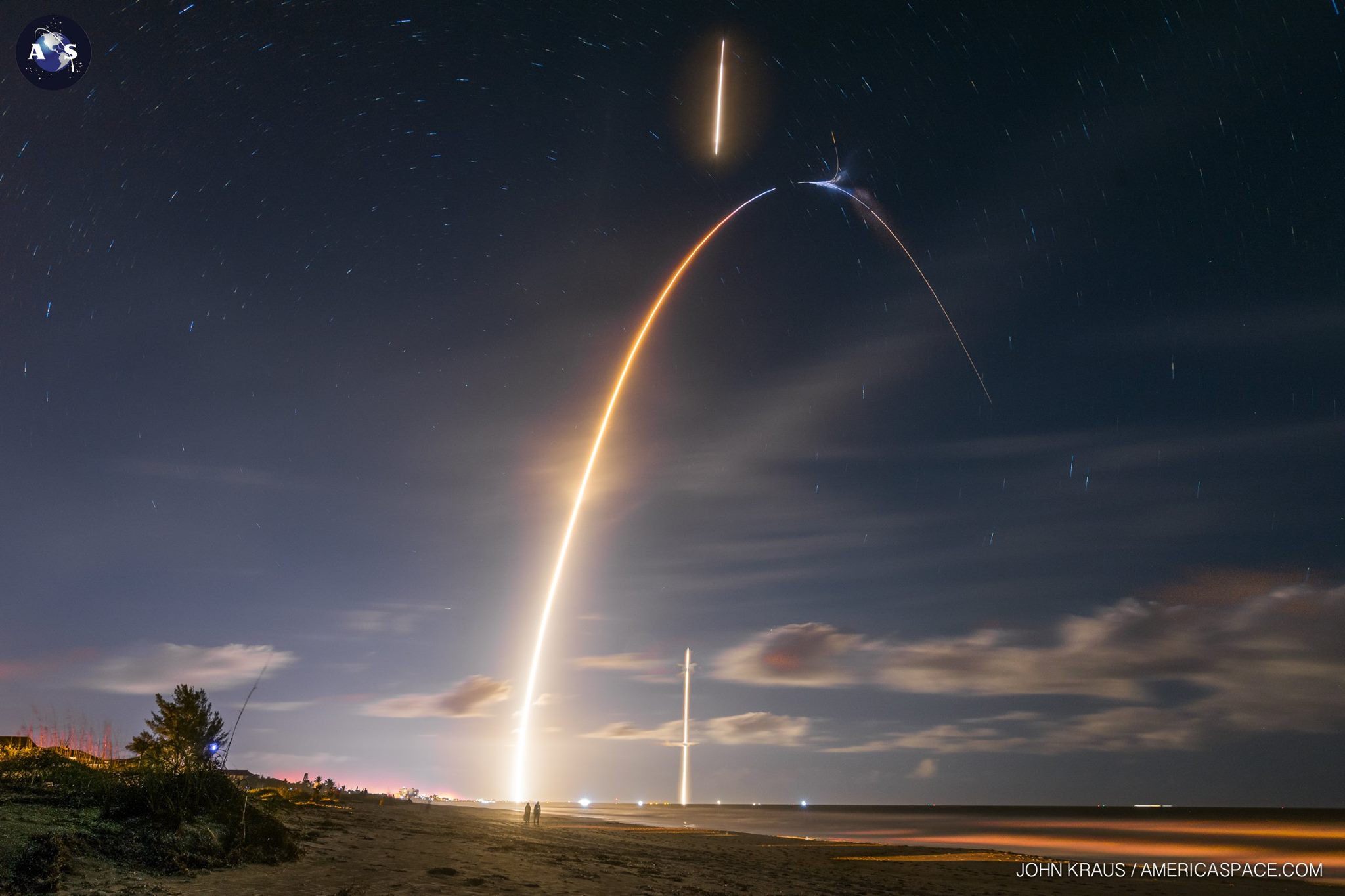
Only days after SpaceX elevated its long-awaited Falcon Heavy booster for pre-Static Fire fit-checks on Pad 39A at the Kennedy Space Center (KSC), the organization has kicked off its 2018 manifest by delivering a long-delayed payload into Low-Earth Orbit (LEO) from neighboring Space Launch Complex (SLC)-40 at Cape Canaveral Air Force Station, Fla. Although tonight’s launch represents SpaceX’s third classified national security payload—known only by the code name “Zuma”—it was accompanied by a veil of unusual secrecy, for not even the sponsoring U.S. Government Agency responsible for the mission is known with certainty. The Upgraded Falcon 9 booster roared aloft at precisely 8 p.m. EST on Sunday, 7 January, and, a few minutes thereafter, its Block 4 first stage returned to Earth and alighted smoothly on Landing Zone (LZ)-1 at the Cape, for potential refurbishment and re-use.
For more than a decade, the delivery of classified national security satellites into orbit on behalf of the U.S. Government has been the exclusive preserve of United Launch Alliance (ULA). Since December 2006, its highly reliable fleet of Delta II, Atlas V and Delta IV vehicles have lofted more than 80 major payloads into space, devoted to reconnaissance and surveillance, navigation and military weather observation, early-warning, communications, electronic intelligence and technology demonstration, in addition to the first four launches of the X-37B Orbital Test Vehicle (OTV) mini-shuttle. With ULA’s recent successful delivery of NROL-52 to orbit and the scheduled Wednesday, 10 January flight of the NROL-47 payload atop a Delta IV Medium heavylifter, the company will likely remain the United States’ mainstay for military operations for some years to come.
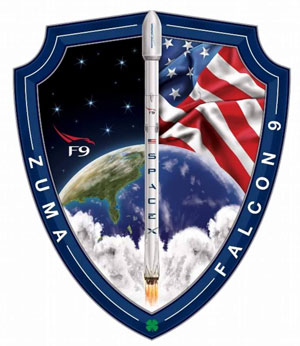
However, the paradigm began to shift noticeably back in April 2014, following the Air Force’s decision to “block-buy” 36 rocket cores from ULA on a sole-source basis. The decision came in response to a 60-percent growth in costs between 2011 and 2014 and the Air Force hoped that the block-buy would provide stability. However, SpaceX CEO Elon Musk filed suit in the Court of Federal Claims against the block-buy, arguing for the right to compete (and to do so less expensively) for national security contracts. “Had SpaceX been awarded the missions ULA received under its recent non-competed 36-core block-buy,” Mr. Musk said at the time, “we would have saved the taxpayers $11.6 billion.” In early July, the U.S. Government filed a request with the court to dismiss SpaceX’s lawsuit, on the basis that Musk’s company was never an actual or prospective bidder for national security contracts in the first place. “SpaceX did not raise any objection to the solicitation at the time it was issued, nor did SpaceX object at any point during the two years while the Air Force negotiated with [United Launch Services],” the government’s defendant noted.
At the time, Air Force Space Command Gen. William Shelton also explained that SpaceX’s main government-related focus at the time of launching Dragon cargo ships to the International Space Station (ISS)—food, clothes, experiments and supplies—“doesn’t begin to represent the catastrophic loss much like a national security payload would”. Gen. Shelton cautioned that such payloads, sometimes costing in excess of $1.5 billion, “have to get there” and that mission assurance could not be compromised.
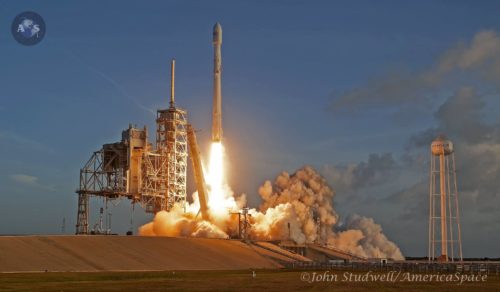
By this stage, however, the Air Force had spent over $60 million to get SpaceX certified for the big-money national security contracts. All told, this reportedly involved 150 people, the fulfilment of 125 certification criteria, over 2,800 discrete tasks, three certification flight demonstrations, 160 payload interface verifications, 21 major subsystems reviews and 700 audits. In mid-July 2014 the company’s fleet of Falcon 9 rockets were verified as having flown a minimum of three successful missions and in May 2015 the Air Force formally certified SpaceX to begin competing as a carrier for major national security payloads. By this time, SpaceX had also dismissed its claim over the block-buy.
Formal certification allowed Mr. Musk’s company to progress deftly towards securing its first national security contracts and in May 2017 it launched the NROL-76 payload for the National Reconnaissance Office. Four months later, it also lofted the X-37B OTV mini-shuttle on its fifth orbital voyage. Today’s flight of Zuma marks SpaceX’s fully classified mission and by far the most secretive, with nothing other than the spacecraft manufacturer—Bethpage, N.Y.-headquartered Northrop Grumman—identified with certainty. Lon Rains, Northrop Grumman’s director of strategic communications, told AmericaSpace in November only that Zuma is destined for a Low-Earth Orbit (LEO). The LEO regime exists up to an altitude of about 1,200 miles (2,000 km) above Earth’s surface, suggestive of Zuma being a reconnaissance or intelligence-gathering sentinel. Indeed, the Upgraded Falcon 9 gave no outward indication of its classified passenger, with the payload fairing emblazoned only with the words “Northrop Grumman”.
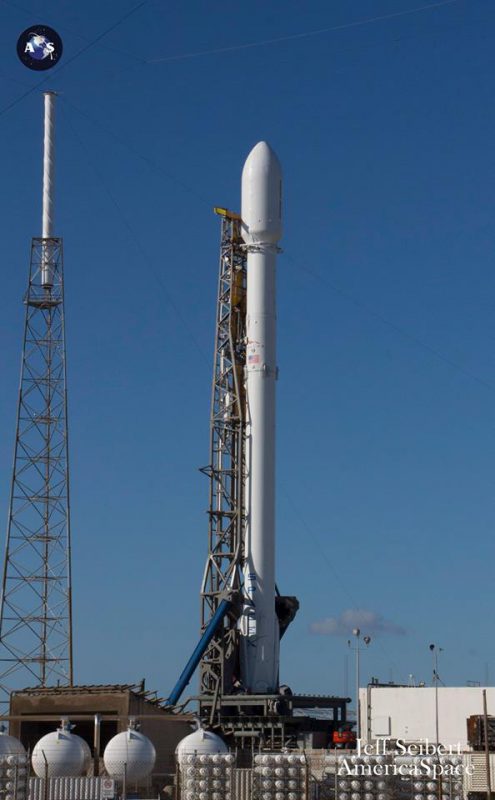
The mission was originally targeted for launch several weeks ago, with the 230-foot-tall (70-meter) booster transported from the Horizontal Integration Facility (HIF) to Pad 39A in early November and elevated to the vertical. On 11 November, at precisely 6 p.m. EST, the nine Merlin 1D+ first-stage engines roared to life for a few seconds, in the customary Static Fire Test. The successful completion of the test was later announced by SpaceX, together with a target launch date of the 15th. In line with rules imposed after the September 2016 on-the-pad loss of the Amos-6 mission, the Upgraded Falcon 9 was then returned to a horizontal configuration and transported back to the HIF for the installation of its bullet-like payload fairing and Zuma. The complete stack came back out to the pad on the evening of 14 November and was again raised to the vertical, in readiness for launch.
Early the next morning, however, SpaceX noted a 24-hour slip until 16 November. “Rocket and payload remain healthy,” it was explained, “and the teams will use the extra day to conduct additional mission assurance work.” However, it was subsequently revealed that the mission would be indefinitely stood-down, to allow engineers to closely examine data from recent payload-fairing testing for another customer. SpaceX retained Eastern Range approval for a backup opportunity on the 17th, but opted to “complete the data review”, after which a new launch date would be established. In the meantime, SLC-40 returned to service on 15 December, with the launch of the CRS-13 Dragon cargo mission, followed by the fourth batch of Iridium NEXT satellites from Vandenberg Air Force Base, Calif., a week later. The Zuma launch was rescheduled to take place during a two-hour “window”, extending from 8:00 p.m. through 10 p.m. EST Thursday, 4 January, from SLC-40, leaving Pad 39A fully available for the maiden flight of the Falcon Heavy. This was subsequently moved to the evening of Friday, 5 January, with the booster put through a propellant loading test earlier this week. “Team at the Cape performed a propellant loading test of Falcon 9 on Pad 40 this morning,” SpaceX tweeted Wednesday, 3 January. “Additional static fire test of the rocket was not necessary.”
As circumstances transpired, another delay was in the works, as frigid weather conditions hampered propellant loading tests. Late Thursday, SpaceX tweeted: “Team at the Cape completed additional propellant loading tests today. Extreme weather slowed operations, but Falcon 9 and Zuma spacecraft are healthy and go for launch—now targeting 7 January.”
According to the 45th Weather Squadron at Patrick Air Force Base, there existed a 80-percent chance of acceptable conditions at T-0 on Sunday, diminishing to 70-percent-favorable for the backup attempt on Monday, 8 January. The main weather constraints centered on cumulus clouds with the showers and thick clouds with the return of a frontal boundary. “Winds will become easterly and gusty, bringing isolated rain showers to coastal regions.” In the event of a scrub to Monday, the 45th noted that weather would “continue to deteriorate as the next frontal system approaches the Panhandle” and “showers will become widespread as the atmosphere destabilizes”. Launch time for both the primary and backup windows extended for two hours, running from 8:00 p.m. EST through 10:00 p.m. EST.
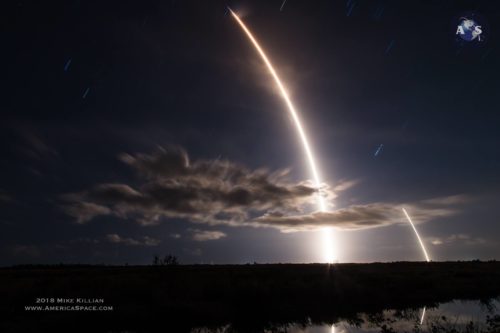
By Sunday afternoon, the 45th Weather Squadron noted a marked improvement, with conditions at T-0 expected to be around 90-percent favourable. However, a deterioration to around 70-percent was still the official expectation in the event of a scrub and 24-hour recycle to Monday. “Winds across the Space Coast have become northeasterly, bringing in clouds off the water,” it was explained at 2 p.m. EST Sunday. “These clouds will thicken and become more prevalent after sunset and through the day tomorrow. The primary weather threat remains a slight risk of cumulus clouds developing with the on-shore flow.” Aware of the more pessimistic outlook for Monday night, SpaceX pressed ahead towards a Sunday evening launch. Fueling of the booster with a highly refined form of rocket-grade kerosene (known as “RP-1”) got underway at 6:50 p.m. EST, about 70 minutes before the opening of the launch window. SpaceX later confirmed that it was aiming to launch at 8 p.m., right on the opening of the window. Loading of liquid oxygen got underway at 7:25 p.m.
Liftoff occurred precisely at 8 p.m. and the Upgraded Falcon 9 followed a characteristically perfect ascent trajectory, its first stage providing the muscle for the first 2.5 minutes, before separating. This was the fifth outing for the booster’s Block 4 variant, which serves as a “transitional” vehicle, as SpaceX moves towards the final incarnation of the Upgraded Falcon 9, known as the Block 5. It then commenced a six-minute descent back through Earth’s “sensible” atmosphere, guided by its hypersonic grid-fins and a total of three engine burns, to alight smoothly on Landing Zone (LZ)-1 at Cape Canaveral Air Force Station, Fla. Tonight’s textbook landing at seven minutes and 56 seconds after launch marked the ninth occasion since December 2015 that a returning Falcon has achieved a touchdown on the ground pad. Meanwhile, the second stage picked up the baton to deliver Zuma to orbit, with SpaceX coverage ending with the jettison of the payload fairing at three minutes into the flight.
Looking ahead, the main event for January is expected to be the maiden voyage of the Falcon Heavy, which is only days away from its own Static Fire Test and various sources suggesting a launch as early as the end of the month. It is expected to loft Elon Musk’s midnight cherry-red Tesla Roadster onto a heliocentric trajectory, kicking off up to three Falcon Heavy missions for 2018. SpaceX President Gwynne Shotwell has previously indicated an uplift of up to 50 percent over the 2017 tally of missions, meaning that potentially as many as 28 flights could be achieved this year. Key payloads include the remainder of the Iridium NEXT global mobile communications satellite fleet, up to three Dragon cargo missions to the International Space Station (ISS), several geostationary-orbiting communications satellites and the inaugural unpiloted test-flights of the Commercial Crew Program. Also expected in 2018 is the flight of a pair of tourists around the Moon, as outlined by Mr. Musk last spring.
FOLLOW AmericaSpace on Facebook!
.




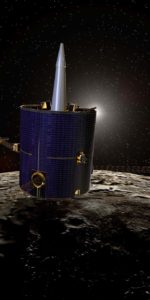
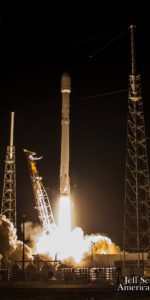
i live by space center and that night launch was fantastic u could see the 1st stage return back and land and it was fantastic space x great job and the sonic boom WOW
Anyone
“This was the fifth outing for the booster’s Block 4 variant, which serves as a “transitional” vehicle, as SpaceX moves towards the final incarnation of the Upgraded Falcon 9, known as the Block 5.”
Is the Block 5 version the booster with the 24 hour turnaround ability that Musk referred to previousely?
It is.